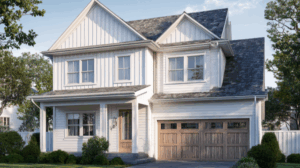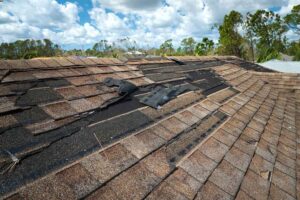Salt Air, Sea Breezes, and the Realities of Coastal Roof Aging
If you’ve owned a home in Rehoboth Beach for any length of time, you already know this: the ocean is beautiful, but the salt air? Not so kind to your roof.
Decks fade, metal rusts, and shingles curl faster than you’d expect. That’s because homes here age differently — especially when it comes to the roof. Constant exposure to sea spray, high humidity, and wind means your roof is dealing with problems that inland homes never see.
At Grand Exteriors, we’ve inspected and repaired hundreds of roofs across Delaware’s coast — and we’ve seen just how quickly salt air roof damage can sneak up on homeowners. That’s why roofing maintenance for coastal regions is more than just routine upkeep — it’s smart, long-term protection.
In This Post, You’ll Learn:
- Why Rehoboth Beach homes face unique roofing challenges
- What coastal roofing problems to look out for
- How to extend the life of your roof with regular maintenance
- Which materials are best for salty, windy environments
- How Grand Exteriors helps local homeowners prevent costly damage
Want a professional opinion on your roof? Schedule a free inspection with Grand Exteriors — no pressure, just honest insight.

Why Rehoboth Beach Roofs Age Faster Than Inland Homes
Living close to the water comes with perks, but it also means your home — and especially your roof — is exposed to more wear. You’re dealing with salt-heavy air, year-round humidity, and wind-driven rain that slowly chip away at even the best materials.
What causes salt air roof damage?
Salt air roof damage happens when airborne salt from the ocean settles on your roofing materials. Over time, it corrodes metal, weakens flashing, and dries out shingles. Add in intense sun and poor ventilation, and you’ve got a recipe for premature roof failure.
What makes Rehoboth Beach roofing problems unique?
Rehoboth homes are particularly vulnerable because of:
- Proximity to the ocean (wind carries salt inland)
- High humidity from March through December
- Frequent storms and tropical weather
- Older homes with outdated ventilation or flashing
- Flat or low-sloped roofs that dry out slower
All of this accelerates deterioration. A 30-year shingle? In Rehoboth, it might give you 18–20 years tops — unless you’re staying on top of it.
What You Should Know Before Addressing Coastal Roofing Issues
Before tackling repairs or upgrades, it helps to know what makes roofing on the coast different — from costs to materials to building codes.
1. What coastal roof maintenance costs
- Routine maintenance (inspections, small fixes): $300–$600/year
- Minor repairs for wind or salt damage: $500–$1,500
- Full roof replacement with coastal-grade materials: $10,000–$25,000+
Grand Exteriors offers payment plans and financing to make larger projects more manageable.
2. Permits and building codes for Rehoboth Beach
- Most minor repairs don’t require permits
- Full replacements do, especially within coastal building zones
- Your roof may also need wind-rated materials and sealed underlayments
We manage all permitting, inspections, and code compliance on your behalf.
3. Use roofing materials designed for the beach
Not all shingles and fasteners are created equal. Coastal homes need:
- Algae-resistant asphalt shingles
- Standing seam metal with salt-resistant coatings
- Stainless steel or coated flashing
- Corrosion-proof ridge caps and fasteners
- Proper ventilation systems to control moisture
Grand Exteriors installs only materials approved by manufacturers for coastal performance.
5 Common Coastal Roofing Problems in Rehoboth Beach (and How to Fix Them)
1. Rust and Corrosion on Flashing and Vents
One of the first signs of coastal roof wear is rust. Salt in the air corrodes metal vents, flashing, and nails, weakening waterproofing and leading to leaks.
Fix: Replace corroded components with stainless steel or marine-grade materials, and check them annually.
2. Shingles Curling, Blistering, or Lifting
Humidity softens shingles while salt and sun dry them out — causing curling, cracking, and seal failure.
Fix: Replace affected shingles with wind-rated, algae-resistant types built for salty air.
3. Mold, Algae, and Black Stains
Dark streaks and moss patches hold moisture against your roof, which accelerates wear and can create soft spots.
Fix: Soft wash the roof once a year and install shingles with copper or zinc granules to prevent regrowth.
4. Soft or Sagging Decking
Moisture that sneaks past weakened shingles or flashing can cause rot in your roof decking.
Fix: Replace compromised wood and improve attic ventilation to help your roof dry out faster.
5. Shortened Roof Lifespan
Even high-quality materials age faster near the coast. Without regular upkeep, you may lose 5–10 years of performance.
Fix: Schedule annual inspections and budget for repairs before problems get expensive.
Built for the Beach: How Grand Exteriors Solves Salt Air Roofing Challenges
We’ve been working on coastal roofs long enough to know that Rehoboth Beach homes need more than just average materials and standard installation.
What Grand Exteriors does differently:
- Certified installation of coastal-grade shingles and metal roofing
- Full inspections using drones and attic evaluations
- Honest advice and no pushy sales tactics
- 10-year workmanship warranties
- Insurance claim support and documentation
- Permit handling and HOA communication
We’ve seen what works (and what fails) in this area, and we’re here to help you avoid costly repairs by doing it right the first time.
Pros and Cons of proactive roofing in coastal areas
Pros:
- Extends your roof’s life
- Lowers risk of emergency leaks or damage
- Maintains property value and insurance compliance
- Prevents mold, rot, and structural damage
Cons:
- Coastal materials can cost more up front
- You’ll need to plan for regular inspections and occasional upkeep
That said, investing in quality roofing now pays off in fewer headaches — and a stronger, longer-lasting roof.

Rehoboth Beach Roofing FAQs: Questions Coastal Homeowners Ask Most
What is the best roofing material for salt air?
The best roofing material for salt air is algae-resistant asphalt or marine-grade standing seam metal. These materials are built to withstand corrosion and UV exposure common in coastal climates.
How often should coastal homes have roof inspections?
Coastal homes in Rehoboth Beach should have roof inspections at least once per year. Annual inspections help catch early signs of salt, wind, and moisture damage before they turn into costly repairs.
Does salt air really shorten the lifespan of a roof?
Yes, salt air shortens the lifespan of most roofing systems. It causes corrosion, dries out shingles, and traps moisture — all of which accelerate aging compared to inland homes.
Will insurance cover salt air roof damage?
Insurance typically does not cover slow corrosion from salt exposure. However, storm damage, wind lift, and related roof leaks may be covered if properly documented after an event.
What does a coastal roof inspection include?
A coastal roof inspection includes a full review of flashing, shingles, ventilation, and decking for signs of rust, algae, trapped moisture, or material failure. Drone imagery is also used to check hard-to-see areas.
Can I pressure wash my roof to remove algae?
No, pressure washing a roof can strip granules and damage materials. The better option is a professional soft wash using low pressure and safe, roof-approved cleaners.
Final Thoughts: Protect Your Roof from Rehoboth Beach’s Coastal Climate
Rehoboth Beach homes experience more wear and tear — not because of poor construction, but because salt air, humidity, and storms are relentless.
At Grand Exteriors, we help homeowners understand how coastal roofing problems start, how to prevent them, and how to build roofing systems that last — even in challenging environments.
Whether you’re dealing with your first roof in a beach town or maintaining a second home near the coast, we’re here to help.
Schedule your free coastal roof inspection today. Grand Exteriors is ready when you are.




